Automated Packaging Solutions Market
Automated Packaging Solutions Market Size and Share Forecast Outlook 2025 to 2035
Automated packaging solutions market is projected to grow from USD 80.6 billion in 2025 to USD 162.2 billion by 2035, at a CAGR of 7.2%. Packaging Robots will dominate with a 3740.0% market share, while food & beverage will lead the application segment with a 3350.0% share.
Automated Packaging Solutions Market Forecast and Outlook 2025 to 2035
The global automated packaging solutions market is projected to grow from USD 80.6 billion in 2025 to approximately USD 162.2 billion by 2035, recording an absolute increase of USD 81.6 billion over the forecast period. This represents total growth of 101.2%, with the market expected to expand at a CAGR of 7.2% between 2025 and 2035.
Quick Stats for Automated Packaging Solutions Market
- Automated Packaging Solutions Market Value (2025): USD 80.6 billion
- Automated Packaging Solutions Market Forecast Value (2035): USD 162.2 billion
- Automated Packaging Solutions Market Forecast CAGR: 7.2%
- Leading Type in Automated Packaging Solutions Market: Packaging Robots (37.2%)
- Key Growth Regions in Automated Packaging Solutions Market: Asia Pacific, North America, and Europe
- Key Players in Automated Packaging Solutions Market: Syntegon Technology GmbH, Crown Packaging Corp., Smurfit Westrock, Rockwell Automation, Siemens AG, Sealed Air Corp., ABB Ltd, Mpac Group plc, Multivac Group, Emerson Electric Co.
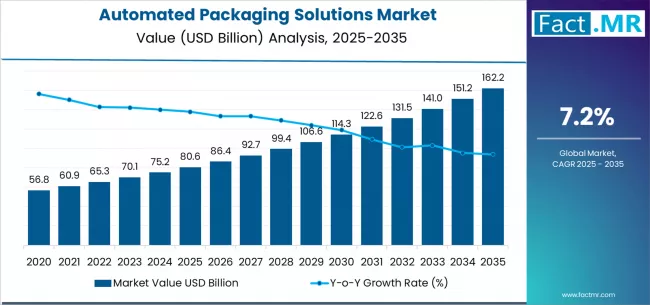
The market is forecasted to nearly double during this period, supported by growing demand for industrial automation, increasing adoption across the food and beverage and healthcare sectors, and a global shift toward production efficiency and labor optimization. Expanding e-commerce operations, rising packaging complexity, and the integration of robotics and data-driven control systems are collectively transforming how manufacturers approach packaging line design and performance management.
Between 2025 and 2030, the automated packaging solutions market is projected to expand from USD 80.6 billion to USD 115.1 billion, adding USD 34.5 billion and accounting for approximately 42.3% of total forecast growth. This phase will be driven by the widespread adoption of packaging robots, particularly articulated and delta configurations, across food processing, pharmaceuticals, and consumer goods manufacturing.
E-commerce fulfillment centers and logistics hubs are rapidly investing in automated case packing, palletizing, and labeling systems to meet increasing order volumes and minimize manual handling requirements. The growing demand for hygienic packaging systems and traceable supply chain solutions in healthcare and food applications further supports automation adoption. Manufacturers are prioritizing modular and flexible automation architectures that can adapt to rapid product changeovers and varying batch sizes, reflecting the trend toward high-mix, low-volume production environments.
From 2030 to 2035, the market is forecast to grow from USD 115.1 billion to USD 162.2 billion, contributing USD 47.1 billion and accounting for nearly 57.7% of decade-long growth. This period is expected to mark the convergence of artificial intelligence (AI), machine vision, and collaborative robotics (cobots) within packaging operations.
AI-driven systems will enable predictive maintenance, real-time fault detection, and optimization of energy consumption across production lines. Automation vendors are expected to expand their portfolios to include self-learning packaging equipment and digital twin-based system modeling, enhancing overall process reliability and operational insight.
The growing adoption of Industry 4.0 standards, coupled with environmental sustainability mandates, will accelerate demand for energy-efficient packaging systems capable of minimizing material waste and reducing carbon footprint. Customized automation solutions tailored to specific end-user requirements such as flexible pouch packaging, recyclable materials handling, and secondary packaging optimization will emerge as key differentiators in mature markets.
Between 2020 and 2025, the automated packaging solutions market demonstrated consistent expansion, supported by heightened awareness of automation’s role in improving operational resilience, particularly during labor shortages and supply chain disruptions. Manufacturers increasingly integrated robotics, motion control, and vision inspection systems to achieve higher throughput and product consistency.
Advancements in servo-driven mechanisms, end-of-arm tooling, and machine learning-based quality control further elevated system accuracy and adaptability. The steady growth of global manufacturing capacity, combined with rising demand for automation in logistics and fulfillment operations, laid the foundation for sustained market development through the next decade.
Automated Packaging Solutions Market Key Takeaways
| Metric | Value |
|---|---|
| Estimated Value in (2025E) | USD 80.6 billion |
| Forecast Value in (2035F) | USD 162.2 billion |
| Forecast CAGR (2025 to 2035) | 7.2% |
Why is the Automated Packaging Solutions Market Growing?
Market expansion is being supported by the increasing demand for manufacturing automation and the corresponding need for high-performance packaging equipment in automated packaging applications across global manufacturing and logistics operations. Modern manufacturers are increasingly focused on advanced automated packaging solutions that can improve operational efficiency, reduce labor costs, and enhance packaging quality while meeting stringent speed requirements. The proven efficacy of automated packaging solutions in various industrial applications makes them an essential component of comprehensive production strategies and supply chain programs.
The growing emphasis on Industry 4.0 transformation and operational optimization is driving demand for ultra-efficient automated packaging solutions that meet stringent performance specifications and productivity requirements for manufacturing applications. Manufacturers' preference for reliable, high-speed equipment that can ensure consistent packaging outcomes is creating opportunities for innovative automated packaging designs and customized industrial solutions. The rising influence of sustainability guidelines and labor shortage pressures is also contributing to increased adoption of advanced-grade automated packaging solutions across different manufacturing applications and logistics systems requiring sophisticated automation technology.
Opportunity Pathways - Automated Packaging Solutions Market
The automated packaging solutions market represents a specialized growth opportunity, expanding from USD 80.6 billion in 2025 to USD 162.2 billion by 2035 at a 7.2% CAGR. As manufacturers prioritize operational efficiency, labor optimization, and production performance in complex manufacturing operations, automated packaging systems have evolved from a niche automation technology to an essential component enabling throughput enhancement, quality control, and multi-stage production across manufacturing operations and specialized logistics applications.
The convergence of industrial expansion, increasing e-commerce adoption, specialized healthcare facility growth, and sustainability requirements creates momentum in demand. High-speed formulations offering superior packaging performance, cost-effective robotic systems balancing performance with economics, and specialized collaborative variants for critical applications will capture market premiums, while geographic expansion into high-growth Asian manufacturing markets and emerging market penetration will drive volume leadership. Industry emphasis on operational efficiency and labor productivity provides structural support.
- Pathway A - Packaging Robots Dominance: Leading with 37.2% market share, packaging robot applications drive primary demand through complex manufacturing workflows requiring comprehensive automation systems for packaging operations. Advanced formulations enabling improved operational efficiency, reduced labor requirements, and enhanced packaging outcomes command premium pricing from manufacturers requiring stringent performance specifications and speed compliance. Expected revenue pool: USD 30.1-60.7 billion.
- Pathway B - Asia Pacific Regional Leadership: Dominating with 34.1% market share through an optimal balance of manufacturing capacity and adoption growth, Asia Pacific serves most industrial applications while meeting regional requirements. This region addresses both performance standards and economic considerations, making it the preferred location for automated packaging production and deployment operations seeking reliable solutions. Opportunity: USD 27.5-55.3 billion.
- Pathway C - Asian Market Acceleration: China (8.2% CAGR) and India (7.9% CAGR) lead global growth through smart manufacturing expansion, e-commerce fulfillment development, and domestic automated packaging demand. Strategic partnerships with local manufacturers, Industry 4.0 expertise, and supply chain localization enable the expansion of automation technology in major industrial hubs. Geographic expansion upside: USD 25.0-45.0 billion.
- Pathway D - Food & Beverage Application Segment: Food & beverage applications serve specialized packaging requiring exceptional performance specifications for critical hygiene operations. Advanced formulations supporting speed requirements, complex full-line applications, and performance-sensitive processes command significant premiums from advanced manufacturing organizations and specialized processing facilities. Revenue potential: USD 27.0-54.3 billion.
- Pathway E - Advanced AI & Collaborative Robotics Systems: Companies investing in sophisticated artificial intelligence technologies, collaborative robot integration, and predictive maintenance capabilities gain competitive advantages through consistent equipment performance and operational reliability. Advanced capabilities enabling customized specifications and smart monitoring capture premium manufacturing partnerships. Technology premium: USD 12.0-24.0 billion.
- Pathway F - Supply Chain Optimization & Service Support: Specialized distribution networks, strategic maintenance management, and reliable after-sales service systems create competitive differentiation in manufacturing markets requiring consistent automated packaging availability. Companies offering guaranteed uptime, technical support, and comprehensive operational documentation gain preferred supplier status with compliance-focused manufacturers. Supply chain value: USD 8.0-16.0 billion.
- Pathway G - Emerging Applications & Market Development: Beyond traditional manufacturing segments, automated packaging solutions in omnichannel logistics, sustainable packaging systems, and advanced pharmaceutical applications represent growth opportunities. Companies developing new applications, supporting R&D initiatives, and expanding into adjacent industrial markets capture incremental demand while diversifying revenue streams. Emerging opportunity: USD 6.0-12.0 million.
Segmental Analysis
The market is segmented by type, application, and region. By type, the market is divided into packaging robots, secondary automated packaging solutions, automated conveyor & sorting systems, and tertiary & palletizing automation.
Based on application, the market is categorized into food & beverage, healthcare, personal care & cosmetics, electrical & electronics, and others. Regionally, the market is divided into Asia Pacific, North America, Europe, Latin America, and Middle East & Africa.
What Makes Packaging Robots the Dominant Type in the Automated Packaging Solutions Market?
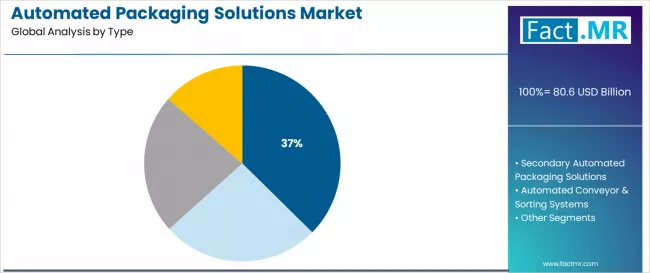
The packaging robots segment is projected to account for 37.2% of the automated packaging solutions market in 2025, reaffirming its position as the category's dominant type. Manufacturers increasingly recognize the optimal balance of performance and versatility offered by packaging robots for most industrial applications, particularly in filling, sealing, labeling, and pick-and-place operations. This type addresses both performance requirements and operational considerations while providing reliable automation solutions across diverse manufacturing applications.
This type forms the foundation of most automation protocols for packaging applications, as it represents the most widely accepted and commercially viable category of automated packaging solutions in the industry. Speed standards and extensive operational testing continue to strengthen confidence in packaging robot formulations among manufacturing and logistics operators.
Within the packaging robots segment, collaborative robots (cobots) account for 43% of segment revenue and demonstrate strong growth at 7.9% CAGR, driven by flexibility and safety advantages in mixed production environments. With increasing recognition of the labor shortage challenges in manufacturing operations, packaging robot systems align with both operational efficiency and workforce optimization goals, making them the central growth driver of comprehensive automation strategies. The segment demonstrates the fastest growth at 7.8% CAGR overall.
Which Application Segment Drives Maximum Demand in the Automated Packaging Solutions Market?
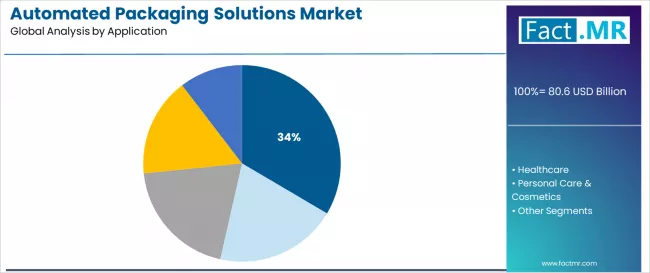
Food & beverage applications are projected to represent 33.5% of automated packaging solutions demand in 2025, underscoring its role as the largest end-user segment driving market adoption and growth. Manufacturers recognize that food & beverage requirements, including hygiene compliance, high-speed demands, and full-line automation needs, often require advanced packaging solutions that standard manual technologies cannot adequately provide.
Automated packaging solutions offer enhanced operational efficiency and quality consistency in food and beverage packaging applications. The segment is supported by the growing nature of food processing expansion, requiring sophisticated packaging systems, and the increasing recognition that advanced automated packaging solutions can improve production performance and hygiene outcomes.
Manufacturers are increasingly adopting evidence-based operational guidelines that recommend specific automation solutions for optimal packaging results. Within the food & beverage segment, dairy & snacks packaging accounts for 38% of segment revenue and demonstrates solid growth at 7.5% CAGR, driven by high-volume processing requirements.
Healthcare follows with 22.4% market share and demonstrates the fastest CAGR of 7.8%, driven by stringent regulatory requirements and pharmaceutical blister packaging which constitutes 46% of healthcare segment usage. Personal care & cosmetics accounts for 14.6% share, benefiting from flexible labeling and eco-friendly packaging demand.
What are the Drivers, Restraints, and Key Trends of the Automated Packaging Solutions Market?
The automated packaging solutions market is advancing steadily due to increasing recognition of automation importance and growing demand for high-speed packaging systems across the manufacturing and logistics sectors.
However, the market faces challenges, including high initial capital investment requirements, potential for integration complexity during implementation, and concerns about maintenance expertise for specialized automation equipment. Innovation in collaborative robotics and artificial intelligence protocols continues to influence product development and market expansion patterns.
Expansion of Industry 4.0 Integration and Smart Manufacturing Technologies
The growing adoption of Industry 4.0 manufacturing practices is enabling the development of more sophisticated automated packaging systems that can meet stringent connectivity requirements.
Specialized smart manufacturing facilities offer comprehensive IoT integration capabilities, including advanced predictive maintenance and data analytics processes that are particularly important for achieving operational excellence in packaging applications.
Advanced manufacturing environments provide access to intelligent automation equipment that can optimize production performance and reduce downtime risks while maintaining cost-effectiveness for large-scale manufacturing operations.
Integration of Artificial Intelligence Systems and Vision-Guided Robotics
Modern manufacturing organizations are incorporating digital technologies such as real-time quality inspection, automated defect detection systems, and AI-driven optimization to enhance automated packaging reliability and operational efficiency.
These technologies improve packaging accuracy, enable continuous quality monitoring, and provide better coordination between production lines and logistics throughout the manufacturing cycle. Advanced digital platforms also enable customized performance analytics and early identification of potential equipment failures or quality deviations, supporting reliable industrial production.
Analysis of the Automated Packaging Solutions Market by Key Countries
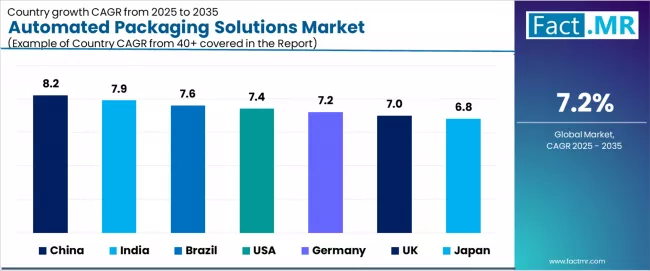
| Country | CAGR (2025-2035) |
|---|---|
| China | 8.2% |
| India | 7.9% |
| Brazil | 7.6% |
| USA | 7.2% |
| Germany | 7.2% |
| UK | 7.0% |
| Japan | 6.8% |
The automated packaging solutions market is experiencing varied growth globally, with China leading at an 8.2% CAGR through 2035, driven by the expansion of smart manufacturing initiatives, increasing e-commerce fulfillment capabilities, and growing domestic demand for high-performance automated packaging solutions. India follows at 7.9%, supported by F&B packaging modernization, growing recognition of modular robotic system importance, and expanding healthcare packaging capacity.
Brazil records 7.6% growth, with a focus on developing consumer goods and beverage logistics automation industries. USA shows 7.2% growth, representing mature automation base trends and AI-enabled robotic palletizer adoption. Germany demonstrates 7.2% growth, emphasizing Industry 4.0 leadership and energy-efficient automation focus.
The UK records 7.0% growth with FMCG automation upgrades and robotics adoption driven by labor shortages, while Japan shows 6.8% growth, representing robotics-intensive packaging modernization and demographic labor constraint challenges.
How is China Leading the Automated Packaging Solutions Market Growth?
The automated packaging solutions market in China is projected to exhibit robust growth with a CAGR of 8.2% through 2035, driven by ongoing smart manufacturing expansion and increasing recognition of high-performance automated packaging solutions as essential production components for complex manufacturing operations.
The country's expanding e-commerce infrastructure and growing availability of specialized automation capabilities are creating significant opportunities for automated packaging adoption across both domestic and export-oriented manufacturing facilities. Major international and domestic automation manufacturers are establishing comprehensive production and distribution networks to serve the growing population of manufacturers and logistics facilities requiring high-performance automated packaging solutions across food processing and e-commerce applications throughout China's major industrial hubs.
The Chinese government's strategic emphasis on "Made in China 2025" initiatives and smart manufacturing development is driving substantial investments in specialized automation capabilities. This policy support, combined with the country's large domestic manufacturing market and expanding e-commerce fulfillment requirements, creates a favorable environment for the automated packaging solutions market development. Chinese manufacturers are increasingly focusing on robotic packaging technologies to improve operational capabilities, with automated packaging solutions representing a key component in this industrial transformation.
Government initiatives supporting manufacturing development and automation adoption are driving demand for high-quality automated packaging solutions throughout major production centers, including Shenzhen, Shanghai, and Guangzhou regions. Manufacturing capacity expansion and logistics facility development are supporting appropriate utilization of automated packaging solutions among manufacturers and fulfillment facilities nationwide, with growth in e-commerce operations and food processing services.
What Drives India's Strong Performance in the Automated Packaging Solutions Market?
The automated packaging solutions market in India is expanding at a CAGR of 7.9%, supported by increasing F&B packaging modernization, growing healthcare packaging awareness, and developing manufacturing presence across the country's major industrial clusters. The country's large food processing sector and increasing recognition of efficient automation solutions are driving demand for effective high-quality packaging equipment in both manufacturing and pharmaceutical applications. International automation manufacturers and domestic suppliers are establishing comprehensive distribution channels to serve the growing demand for reliable automated packaging solutions while supporting the country's position as an emerging manufacturing technology market.
India's manufacturing sector continues to benefit from favorable industrial policies, expanding pharmaceutical capabilities, and cost-competitive production infrastructure development. The country's focus on becoming a global manufacturing hub is driving investments in specialized automation technology and modular robotic infrastructure. This development is particularly important for automated packaging applications, as manufacturers seek reliable domestic sources for critical production technologies to reduce import dependency and improve supply chain security.
Rising awareness about high-performance automation options and improving modular robotic system capabilities are creating opportunities for specialized automated packaging solutions across manufacturing and pharmaceutical settings in major hubs like Mumbai, Pune, and Bangalore.
Growing industrial infrastructure development and technology adoption are supporting increased access to high-quality automated packaging solutions among organizations requiring comprehensive production capabilities, particularly in food processing and pharmaceutical organizations.
How is Brazil Strengthening its Position in the Automated Packaging Solutions Market?
The automated packaging solutions market in Brazil is projected to exhibit strong growth with a CAGR of 7.6% through 2035, driven by consumer goods expansion and beverage logistics automation capabilities. The country's established FMCG sector and growing packaging automation expertise are creating significant opportunities for automated packaging deployment across both manufacturing and distribution applications. Brazilian manufacturing companies are leveraging their market position to serve the growing demand for reliable automation solutions while supporting the country's position as a regional industrial leader.
The Brazilian market benefits from favorable manufacturing investment, expanding logistics automation programs, and cost-competitive production capabilities. Government initiatives supporting industrial development and logistics modernization are driving demand for efficient automated packaging solutions throughout major manufacturing and distribution centers, including São Paulo, Rio de Janeiro, and industrial regions.
What Makes USA a Key Market for Automated Packaging Solutions?
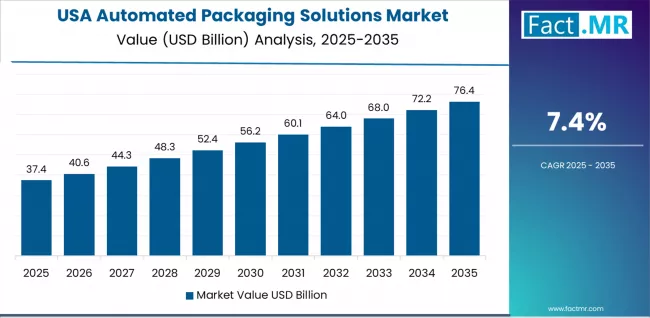
USA's advanced manufacturing technology market demonstrates sophisticated automation deployment with documented automated packaging effectiveness in e-commerce and food processing departments through integration with existing production systems and logistics infrastructure. The country leverages industrial expertise in mature automation base to maintain a 7.2% CAGR through 2035.
Manufacturing sectors, including major industrial areas, showcase advanced installations where automated packaging systems integrate with comprehensive enterprise resource planning systems and production platforms to optimize operational accuracy and workflow effectiveness.
American manufacturers prioritize system reliability and productivity compliance in equipment selection, creating demand for premium automated packaging solutions with advanced features, including AI enablement and integration with US manufacturing standards. The market benefits from established automation industry infrastructure and a willingness to invest in advanced automated packaging solutions that provide long-term operational benefits and compliance with labor regulations.
Why is Germany a Strategic Market for Automated Packaging Solutions Growth?
Germany's market expansion benefits from diverse industrial demand, including manufacturing modernization in Munich and Stuttgart, Industry 4.0 programs, and government sustainability programs that increasingly incorporate automated packaging solutions for operational enhancement applications. The country maintains a 7.2% CAGR through 2035, driven by rising automation awareness and increasing adoption of energy-efficient benefits, including superior operational capabilities and reduced energy consumption.
Market dynamics focus on cost-effective automated packaging solutions that balance advanced performance features with sustainability considerations important to German industrial operators. Growing manufacturing infrastructure creates demand for modern automation systems in new production facilities and equipment modernization projects. Regional efficiency requirements are driving a diverse product portfolio from basic automated packaging solutions to advanced sustainable platforms.
How is Japan Emphasizing Precision in Automated Packaging Solutions Applications?
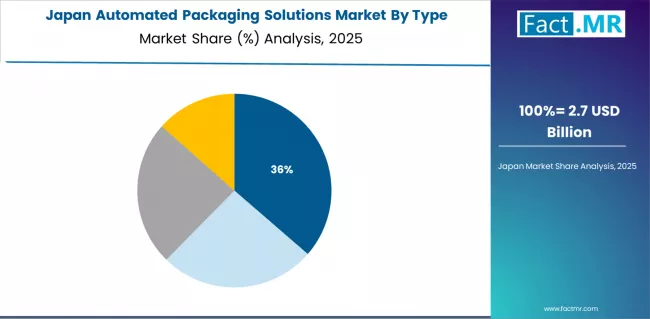
Japan demonstrates steady market development with a 6.8% CAGR through 2035, distinguished by manufacturers' preference for high-quality automated packaging solutions that integrate seamlessly with existing production equipment and provide reliable long-term operation in specialized manufacturing applications. The market prioritizes advanced features, including precision robotics algorithms, quality validation, and integration with comprehensive production platforms that reflect Japanese industrial expectations for technological sophistication and operational excellence.
Japanese manufacturers focus on system reliability and precision in production development, creating demand for premium automated packaging solutions with advanced features including automated monitoring and comprehensive technical support. The market benefits from established robotics research infrastructure and investment in packaging modernization technology that provides long-term production benefits. Premium focus on robotics-intensive packaging systems with advanced precision capabilities and high-reliability features supports market growth, along with demographic labor constraint challenges driving automation adoption.
What Positions UK as a Growing Automated Packaging Solutions Market?
UK's market expansion benefits from diverse industrial demand, including FMCG automation upgrades and labor shortage-driven robotics adoption. The country maintains a 7.0% CAGR through 2035, driven by rising automation investment and increasing preference for advanced packaging solutions through modernization programs. The market prioritizes advanced features, including productivity validation and integration with comprehensive operational platforms that reflect UK industrial expectations for efficiency and operational reliability.
British manufacturers focus on labor optimization in equipment development, creating demand for premium automated packaging solutions with advanced features including automated quality monitoring and comprehensive operational support. FMCG automation upgrade programs and shortage-driven robotics implementation are driving procurement requirements for advanced packaging automation solutions.
Europe Market Split by Country
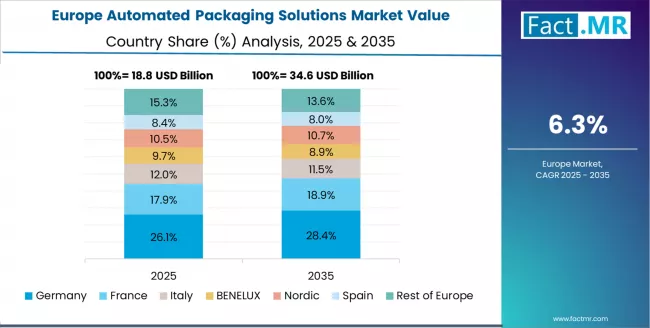
The automated packaging solutions market in Europe is projected to grow from USD 20.7 billion in 2025 to USD 41.7 billion by 2035, registering a CAGR of 7.3% over the forecast period. Germany is expected to maintain its leadership position with a 31.2% market share in 2025, rising to 32.1% by 2035, supported by its advanced Industry 4.0 infrastructure, energy-efficient automation capabilities, and strong manufacturing presence throughout major production regions.
France follows with a 19.8% share in 2025, projected to reach 20.3% by 2035, driven by advanced food processing protocols, automation integration, and expanding pharmaceutical packaging networks serving both domestic and international markets. The UK holds a 17.5% share in 2025, expected to increase to 18.1% by 2035, supported by FMCG automation upgrades and growing adoption of robotics solutions driven by labor shortage challenges.
Italy commands a 14.3% share in 2025, projected to reach 14.7% by 2035, while Spain accounts for 10.7% in 2025, expected to reach 11.0% by 2035. The rest of Europe region, including Nordic countries, Eastern Europe, and smaller Western European markets, is anticipated to hold 6.5% in 2025, declining slightly to 3.8% by 2035, attributed to market consolidation toward larger core markets with established manufacturing and automation capabilities.
Competitive Landscape of the Automated Packaging Solutions Market
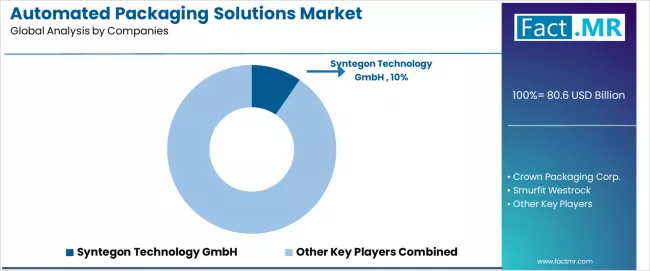
The automated packaging solutions market is characterized by competition among established automation manufacturers, specialty robotics companies, and industrial technology suppliers focused on delivering high-quality, consistent, and reliable packaging automation systems.
Companies are investing in product technology advancement, AI integration enhancement, strategic partnerships, and customer technical support to deliver effective, efficient, and reliable automated packaging solutions that meet stringent manufacturing and logistics requirements. Product optimization, performance validation protocols, and supply chain strategies are central to strengthening product portfolios and market presence.
Syntegon Technology GmbH leads the market with a 9.6% global share, offering comprehensive high-quality automated packaging solutions with a focus on modular design and operational reliability for pharmaceutical and food applications. The company introduced modular cobot-based secondary packaging lines in 2025, strengthening its market position.
Crown Packaging Corp. holds 8.4% market share, providing specialized packaging automation with emphasis on sustainable carton automation systems and comprehensive technical support services.
Smurfit Westrock controls 8.0% share, focusing on merged sustainable fiber-based packaging technologies integrated with automated systems. Rockwell Automation maintains 7.8% share, delivering AI-driven solutions with the launch of "FactoryTalk Design Hub" for packaging orchestration and strong performance capabilities.
Siemens AG operates with 7.5% share, focusing on bringing IoT-based predictive maintenance suites to specialized packaging applications and emerging markets through comprehensive digital platforms. Sealed Air Corp. provides 7.1% share through smart film waste-reduction automation, across multiple industrial applications and sustainable packaging operations.
ABB Ltd holds 6.8% share, specializing in expanded IRB 390 FlexPicker robot range for food & beverage operations with emphasis on high-speed performance. Mpac Group plc maintains 6.3% share, providing "Eagle" high-speed case-packer series and technical expertise to enhance market accessibility and customer access to essential packaging automation. Multivac Group controls 6.1% share, focusing on modular thermoforming automation, while Emerson Electric Co. accounts for 5.9% share with integrated vision-guided palletizing and sealing solutions.
The competitive landscape emphasizes technological differentiation through artificial intelligence integration, collaborative robotics deployment, and predictive maintenance capabilities. Leading manufacturers are investing in Industry 4.0 connectivity, sustainable packaging technologies, and customer technical service capabilities to strengthen their market positions. Strategic collaborations with food processors, pharmaceutical manufacturers, and e-commerce logistics providers are enabling product customization and application-specific solutions.
Key Players in the Automated Packaging Solutions Market
- Syntegon Technology GmbH
- Crown Packaging Corp.
- Smurfit Westrock
- Rockwell Automation
- Siemens AG
- Sealed Air Corp.
- ABB Ltd
- Mpac Group plc
- Multivac Group
- Emerson Electric Co.
Scope of the Report
| Items | Values |
|---|---|
| Quantitative Value (USD Million)s (2025) | USD 80.6 Billion |
| Type | Packaging Robots, Secondary Automated Packaging Solutions, Automated Conveyor & Sorting Systems, Tertiary & Palletizing Automation |
| Application | Food & Beverage, Healthcare, Personal Care & Cosmetics, Electrical & Electronics, Others |
| Regions Covered | Asia Pacific, North America, Europe, Latin America, Middle East & Africa |
| Countries Covered | China, USA, Germany, Japan, India, Brazil, UK and 40+ countries |
| Key Companies Profiled | Syntegon Technology GmbH, Crown Packaging Corp., Smurfit Westrock, Rockwell Automation, Siemens AG, Sealed Air Corp., ABB Ltd, Mpac Group plc, Multivac Group, and Emerson Electric Co. |
| Additional Attributes | Dollar sales by type and application, regional demand trends, competitive landscape, manufacturer preferences for specific automated packaging solutions, integration with specialty manufacturing supply chains, innovations in automation technologies, performance monitoring, and operational optimization |
Automated Packaging Solutions Market by Segments
-
Type :
- Packaging Robots
- Secondary Automated Packaging Solutions
- Automated Conveyor & Sorting Systems
- Tertiary & Palletizing Automation
-
Application :
- Food & Beverage
- Healthcare
- Personal Care & Cosmetics
- Electrical & Electronics
- Others (E-commerce & Retail)
-
Region :
-
Asia Pacific
- China
- India
- Japan
- South Korea
- ASEAN
- Australia & New Zealand
- Rest of Asia Pacific
-
North America
- USA
- Canada
- Mexico
-
Europe
- Germany
- UK
- France
- Italy
- Spain
- Nordic
- BENELUX
- Rest of Europe
-
Latin America
- Brazil
- Argentina
- Chile
- Rest of Latin America
-
Middle East & Africa
- Kingdom of Saudi Arabia
- Other GCC Countries
- Turkey
- South Africa
- Other African Countries
- Rest of Middle East & Africa
-
Table of Content
- Executive Summary
- Global Market Outlook
- Demand to side Trends
- Supply to side Trends
- Technology Roadmap Analysis
- Analysis and Recommendations
- Market Overview
- Market Coverage / Taxonomy
- Market Definition / Scope / Limitations
- Market Background
- Market Dynamics
- Drivers
- Restraints
- Opportunity
- Trends
- Scenario Forecast
- Demand in Optimistic Scenario
- Demand in Likely Scenario
- Demand in Conservative Scenario
- Opportunity Map Analysis
- Product Life Cycle Analysis
- Supply Chain Analysis
- Investment Feasibility Matrix
- Value Chain Analysis
- PESTLE and Porter’s Analysis
- Regulatory Landscape
- Regional Parent Market Outlook
- Production and Consumption Statistics
- Import and Export Statistics
- Market Dynamics
- Global Market Analysis 2020 to 2024 and Forecast, 2025 to 2035
- Historical Market Size Value (USD Million) Analysis, 2020 to 2024
- Current and Future Market Size Value (USD Million) Projections, 2025 to 2035
- Y to o to Y Growth Trend Analysis
- Absolute $ Opportunity Analysis
- Global Market Pricing Analysis 2020 to 2024 and Forecast 2025 to 2035
- Global Market Analysis 2020 to 2024 and Forecast 2025 to 2035, By Type
- Introduction / Key Findings
- Historical Market Size Value (USD Million) Analysis By Type, 2020 to 2024
- Current and Future Market Size Value (USD Million) Analysis and Forecast By Type, 2025 to 2035
- Packaging Robots
- Secondary Automated Packaging Solutions
- Automated Conveyor & Sorting Systems
- Tertiary & Palletizing Automation
- Y to o to Y Growth Trend Analysis By Type, 2020 to 2024
- Absolute $ Opportunity Analysis By Type, 2025 to 2035
- Global Market Analysis 2020 to 2024 and Forecast 2025 to 2035, By Application
- Introduction / Key Findings
- Historical Market Size Value (USD Million) Analysis By Application, 2020 to 2024
- Current and Future Market Size Value (USD Million) Analysis and Forecast By Application, 2025 to 2035
- Food & Beverage
- Healthcare
- Personal Care & Cosmetics
- Electrical & Electronics
- Others (E-commerce & Retail)
- Y to o to Y Growth Trend Analysis By Application, 2020 to 2024
- Absolute $ Opportunity Analysis By Application, 2025 to 2035
- Global Market Analysis 2020 to 2024 and Forecast 2025 to 2035, By Region
- Introduction
- Historical Market Size Value (USD Million) Analysis By Region, 2020 to 2024
- Current Market Size Value (USD Million) Analysis and Forecast By Region, 2025 to 2035
- North America
- Latin America
- Western Europe
- Eastern Europe
- East Asia
- South Asia and Pacific
- Middle East & Africa
- Market Attractiveness Analysis By Region
- North America Market Analysis 2020 to 2024 and Forecast 2025 to 2035, By Country
- Historical Market Size Value (USD Million) Trend Analysis By Market Taxonomy, 2020 to 2024
- Market Size Value (USD Million) Forecast By Market Taxonomy, 2025 to 2035
- By Country
- USA
- Canada
- Mexico
- By Type
- By Application
- By Country
- Market Attractiveness Analysis
- By Country
- By Type
- By Application
- Key Takeaways
- Latin America Market Analysis 2020 to 2024 and Forecast 2025 to 2035, By Country
- Historical Market Size Value (USD Million) Trend Analysis By Market Taxonomy, 2020 to 2024
- Market Size Value (USD Million) Forecast By Market Taxonomy, 2025 to 2035
- By Country
- Brazil
- Chile
- Rest of Latin America
- By Type
- By Application
- By Country
- Market Attractiveness Analysis
- By Country
- By Type
- By Application
- Key Takeaways
- Western Europe Market Analysis 2020 to 2024 and Forecast 2025 to 2035, By Country
- Historical Market Size Value (USD Million) Trend Analysis By Market Taxonomy, 2020 to 2024
- Market Size Value (USD Million) Forecast By Market Taxonomy, 2025 to 2035
- By Country
- Germany
- UK
- Italy
- Spain
- France
- Nordic
- BENELUX
- Rest of Western Europe
- By Type
- By Application
- By Country
- Market Attractiveness Analysis
- By Country
- By Type
- By Application
- Key Takeaways
- Eastern Europe Market Analysis 2020 to 2024 and Forecast 2025 to 2035, By Country
- Historical Market Size Value (USD Million) Trend Analysis By Market Taxonomy, 2020 to 2024
- Market Size Value (USD Million) Forecast By Market Taxonomy, 2025 to 2035
- By Country
- Russia
- Poland
- Hungary
- Balkan & Baltic
- Rest of Eastern Europe
- By Type
- By Application
- By Country
- Market Attractiveness Analysis
- By Country
- By Type
- By Application
- Key Takeaways
- East Asia Market Analysis 2020 to 2024 and Forecast 2025 to 2035, By Country
- Historical Market Size Value (USD Million) Trend Analysis By Market Taxonomy, 2020 to 2024
- Market Size Value (USD Million) Forecast By Market Taxonomy, 2025 to 2035
- By Country
- China
- Japan
- South Korea
- By Type
- By Application
- By Country
- Market Attractiveness Analysis
- By Country
- By Type
- By Application
- Key Takeaways
- South Asia and Pacific Market Analysis 2020 to 2024 and Forecast 2025 to 2035, By Country
- Historical Market Size Value (USD Million) Trend Analysis By Market Taxonomy, 2020 to 2024
- Market Size Value (USD Million) Forecast By Market Taxonomy, 2025 to 2035
- By Country
- India
- ASEAN
- Australia & New Zealand
- Rest of South Asia and Pacific
- By Type
- By Application
- By Country
- Market Attractiveness Analysis
- By Country
- By Type
- By Application
- Key Takeaways
- Middle East & Africa Market Analysis 2020 to 2024 and Forecast 2025 to 2035, By Country
- Historical Market Size Value (USD Million) Trend Analysis By Market Taxonomy, 2020 to 2024
- Market Size Value (USD Million) Forecast By Market Taxonomy, 2025 to 2035
- By Country
- Kingdom of Saudi Arabia
- Other GCC Countries
- Turkiye
- South Africa
- Other African Union
- Rest of Middle East & Africa
- By Type
- By Application
- By Country
- Market Attractiveness Analysis
- By Country
- By Type
- By Application
- Key Takeaways
- Key Countries Market Analysis
- USA
- Pricing Analysis
- Market Share Analysis, 2024
- By Type
- By Application
- Canada
- Pricing Analysis
- Market Share Analysis, 2024
- By Type
- By Application
- Mexico
- Pricing Analysis
- Market Share Analysis, 2024
- By Type
- By Application
- Brazil
- Pricing Analysis
- Market Share Analysis, 2024
- By Type
- By Application
- Chile
- Pricing Analysis
- Market Share Analysis, 2024
- By Type
- By Application
- Germany
- Pricing Analysis
- Market Share Analysis, 2024
- By Type
- By Application
- UK
- Pricing Analysis
- Market Share Analysis, 2024
- By Type
- By Application
- Italy
- Pricing Analysis
- Market Share Analysis, 2024
- By Type
- By Application
- Spain
- Pricing Analysis
- Market Share Analysis, 2024
- By Type
- By Application
- France
- Pricing Analysis
- Market Share Analysis, 2024
- By Type
- By Application
- India
- Pricing Analysis
- Market Share Analysis, 2024
- By Type
- By Application
- ASEAN
- Pricing Analysis
- Market Share Analysis, 2024
- By Type
- By Application
- Australia & New Zealand
- Pricing Analysis
- Market Share Analysis, 2024
- By Type
- By Application
- China
- Pricing Analysis
- Market Share Analysis, 2024
- By Type
- By Application
- Japan
- Pricing Analysis
- Market Share Analysis, 2024
- By Type
- By Application
- South Korea
- Pricing Analysis
- Market Share Analysis, 2024
- By Type
- By Application
- Russia
- Pricing Analysis
- Market Share Analysis, 2024
- By Type
- By Application
- Poland
- Pricing Analysis
- Market Share Analysis, 2024
- By Type
- By Application
- Hungary
- Pricing Analysis
- Market Share Analysis, 2024
- By Type
- By Application
- Kingdom of Saudi Arabia
- Pricing Analysis
- Market Share Analysis, 2024
- By Type
- By Application
- Turkiye
- Pricing Analysis
- Market Share Analysis, 2024
- By Type
- By Application
- South Africa
- Pricing Analysis
- Market Share Analysis, 2024
- By Type
- By Application
- USA
- Market Structure Analysis
- Competition Dashboard
- Competition Benchmarking
- Market Share Analysis of Top Players
- By Regional
- By Type
- By Application
- Competition Analysis
- Competition Deep Dive
- Syntegon Technology GmbH
- Overview
- Product Portfolio
- Profitability by Market Segments (Product/Age /Sales Channel/Region)
- Sales Footprint
- Strategy Overview
- Marketing Strategy
- Product Strategy
- Channel Strategy
- Crown Packaging Corp.
- Smurfit Westrock
- Rockwell Automation
- Siemens AG
- Sealed Air Corp.
- ABB Ltd
- Mpac Group plc
- Multivac Group
- Emerson Electric Co.
- Syntegon Technology GmbH
- Competition Deep Dive
- Assumptions & Acronyms Used
- Research Methodology
List Of Table
- Table 1: Global Market Value (USD Million) Forecast by Region, 2020 to 2035
- Table 2: Global Market Value (USD Million) Forecast by Type, 2020 to 2035
- Table 3: Global Market Value (USD Million) Forecast by Application, 2020 to 2035
- Table 4: North America Market Value (USD Million) Forecast by Country, 2020 to 2035
- Table 5: North America Market Value (USD Million) Forecast by Type, 2020 to 2035
- Table 6: North America Market Value (USD Million) Forecast by Application, 2020 to 2035
- Table 7: Latin America Market Value (USD Million) Forecast by Country, 2020 to 2035
- Table 8: Latin America Market Value (USD Million) Forecast by Type, 2020 to 2035
- Table 9: Latin America Market Value (USD Million) Forecast by Application, 2020 to 2035
- Table 10: Western Europe Market Value (USD Million) Forecast by Country, 2020 to 2035
- Table 11: Western Europe Market Value (USD Million) Forecast by Type, 2020 to 2035
- Table 12: Western Europe Market Value (USD Million) Forecast by Application, 2020 to 2035
- Table 13: Eastern Europe Market Value (USD Million) Forecast by Country, 2020 to 2035
- Table 14: Eastern Europe Market Value (USD Million) Forecast by Type, 2020 to 2035
- Table 15: Eastern Europe Market Value (USD Million) Forecast by Application, 2020 to 2035
- Table 16: East Asia Market Value (USD Million) Forecast by Country, 2020 to 2035
- Table 17: East Asia Market Value (USD Million) Forecast by Type, 2020 to 2035
- Table 18: East Asia Market Value (USD Million) Forecast by Application, 2020 to 2035
- Table 19: South Asia and Pacific Market Value (USD Million) Forecast by Country, 2020 to 2035
- Table 20: South Asia and Pacific Market Value (USD Million) Forecast by Type, 2020 to 2035
- Table 21: South Asia and Pacific Market Value (USD Million) Forecast by Application, 2020 to 2035
- Table 22: Middle East & Africa Market Value (USD Million) Forecast by Country, 2020 to 2035
- Table 23: Middle East & Africa Market Value (USD Million) Forecast by Type, 2020 to 2035
- Table 24: Middle East & Africa Market Value (USD Million) Forecast by Application, 2020 to 2035
List Of Figures
- Figure 1: Global Market Pricing Analysis
- Figure 2: Global Market Value (USD Million) Forecast 2020 to 2035
- Figure 3: Global Market Value Share and BPS Analysis by Type, 2025 and 2035
- Figure 4: Global Market Y to o to Y Growth Comparison by Type, 2025 to 2035
- Figure 5: Global Market Attractiveness Analysis by Type
- Figure 6: Global Market Value Share and BPS Analysis by Application, 2025 and 2035
- Figure 7: Global Market Y to o to Y Growth Comparison by Application, 2025 to 2035
- Figure 8: Global Market Attractiveness Analysis by Application
- Figure 9: Global Market Value (USD Million) Share and BPS Analysis by Region, 2025 and 2035
- Figure 10: Global Market Y to o to Y Growth Comparison by Region, 2025 to 2035
- Figure 11: Global Market Attractiveness Analysis by Region
- Figure 12: North America Market Incremental Dollar Opportunity, 2025 to 2035
- Figure 13: Latin America Market Incremental Dollar Opportunity, 2025 to 2035
- Figure 14: Western Europe Market Incremental Dollar Opportunity, 2025 to 2035
- Figure 15: Eastern Europe Market Incremental Dollar Opportunity, 2025 to 2035
- Figure 16: East Asia Market Incremental Dollar Opportunity, 2025 to 2035
- Figure 17: South Asia and Pacific Market Incremental Dollar Opportunity, 2025 to 2035
- Figure 18: Middle East & Africa Market Incremental Dollar Opportunity, 2025 to 2035
- Figure 19: North America Market Value Share and BPS Analysis by Country, 2025 and 2035
- Figure 20: North America Market Value Share and BPS Analysis by Type, 2025 and 2035
- Figure 21: North America Market Y to o to Y Growth Comparison by Type, 2025 to 2035
- Figure 22: North America Market Attractiveness Analysis by Type
- Figure 23: North America Market Value Share and BPS Analysis by Application, 2025 and 2035
- Figure 24: North America Market Y to o to Y Growth Comparison by Application, 2025 to 2035
- Figure 25: North America Market Attractiveness Analysis by Application
- Figure 26: Latin America Market Value Share and BPS Analysis by Country, 2025 and 2035
- Figure 27: Latin America Market Value Share and BPS Analysis by Type, 2025 and 2035
- Figure 28: Latin America Market Y to o to Y Growth Comparison by Type, 2025 to 2035
- Figure 29: Latin America Market Attractiveness Analysis by Type
- Figure 30: Latin America Market Value Share and BPS Analysis by Application, 2025 and 2035
- Figure 31: Latin America Market Y to o to Y Growth Comparison by Application, 2025 to 2035
- Figure 32: Latin America Market Attractiveness Analysis by Application
- Figure 33: Western Europe Market Value Share and BPS Analysis by Country, 2025 and 2035
- Figure 34: Western Europe Market Value Share and BPS Analysis by Type, 2025 and 2035
- Figure 35: Western Europe Market Y to o to Y Growth Comparison by Type, 2025 to 2035
- Figure 36: Western Europe Market Attractiveness Analysis by Type
- Figure 37: Western Europe Market Value Share and BPS Analysis by Application, 2025 and 2035
- Figure 38: Western Europe Market Y to o to Y Growth Comparison by Application, 2025 to 2035
- Figure 39: Western Europe Market Attractiveness Analysis by Application
- Figure 40: Eastern Europe Market Value Share and BPS Analysis by Country, 2025 and 2035
- Figure 41: Eastern Europe Market Value Share and BPS Analysis by Type, 2025 and 2035
- Figure 42: Eastern Europe Market Y to o to Y Growth Comparison by Type, 2025 to 2035
- Figure 43: Eastern Europe Market Attractiveness Analysis by Type
- Figure 44: Eastern Europe Market Value Share and BPS Analysis by Application, 2025 and 2035
- Figure 45: Eastern Europe Market Y to o to Y Growth Comparison by Application, 2025 to 2035
- Figure 46: Eastern Europe Market Attractiveness Analysis by Application
- Figure 47: East Asia Market Value Share and BPS Analysis by Country, 2025 and 2035
- Figure 48: East Asia Market Value Share and BPS Analysis by Type, 2025 and 2035
- Figure 49: East Asia Market Y to o to Y Growth Comparison by Type, 2025 to 2035
- Figure 50: East Asia Market Attractiveness Analysis by Type
- Figure 51: East Asia Market Value Share and BPS Analysis by Application, 2025 and 2035
- Figure 52: East Asia Market Y to o to Y Growth Comparison by Application, 2025 to 2035
- Figure 53: East Asia Market Attractiveness Analysis by Application
- Figure 54: South Asia and Pacific Market Value Share and BPS Analysis by Country, 2025 and 2035
- Figure 55: South Asia and Pacific Market Value Share and BPS Analysis by Type, 2025 and 2035
- Figure 56: South Asia and Pacific Market Y to o to Y Growth Comparison by Type, 2025 to 2035
- Figure 57: South Asia and Pacific Market Attractiveness Analysis by Type
- Figure 58: South Asia and Pacific Market Value Share and BPS Analysis by Application, 2025 and 2035
- Figure 59: South Asia and Pacific Market Y to o to Y Growth Comparison by Application, 2025 to 2035
- Figure 60: South Asia and Pacific Market Attractiveness Analysis by Application
- Figure 61: Middle East & Africa Market Value Share and BPS Analysis by Country, 2025 and 2035
- Figure 62: Middle East & Africa Market Value Share and BPS Analysis by Type, 2025 and 2035
- Figure 63: Middle East & Africa Market Y to o to Y Growth Comparison by Type, 2025 to 2035
- Figure 64: Middle East & Africa Market Attractiveness Analysis by Type
- Figure 65: Middle East & Africa Market Value Share and BPS Analysis by Application, 2025 and 2035
- Figure 66: Middle East & Africa Market Y to o to Y Growth Comparison by Application, 2025 to 2035
- Figure 67: Middle East & Africa Market Attractiveness Analysis by Application
- Figure 68: Global Market - Tier Structure Analysis
- Figure 69: Global Market - Company Share Analysis
- FAQs -
How big is the automated packaging solutions market in 2025?
The global automated packaging solutions market is estimated to be valued at USD 80.6 billion in 2025.
What will be the size of automated packaging solutions market in 2035?
The market size for the automated packaging solutions market is projected to reach USD 162.2 billion by 2035.
How much will be the automated packaging solutions market growth between 2025 and 2035?
The automated packaging solutions market is expected to grow at a 7.2% CAGR between 2025 and 2035.
What are the key product types in the automated packaging solutions market?
The key product types in automated packaging solutions market are packaging robots, secondary automated packaging solutions, automated conveyor & sorting systems and tertiary & palletizing automation.
Which application segment to contribute significant share in the automated packaging solutions market in 2025?
In terms of application, food & beverage segment to command 3350.0% share in the automated packaging solutions market in 2025.